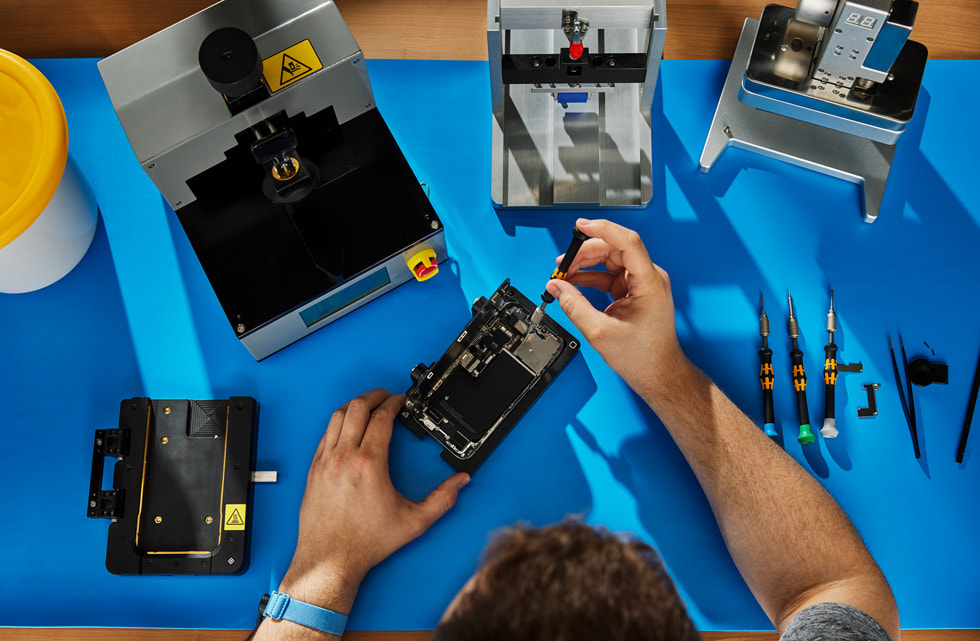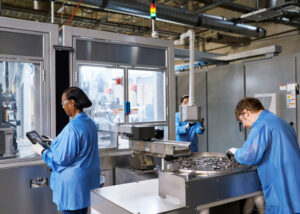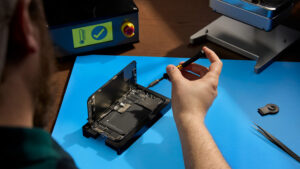Initiatives and Case Studies

Apple: Repair services and recycled content
Apple has committed to becoming carbon neutral for its entire carbon footprint by 2030. Apple is focused on decarbonising the three largest sources of its emissions - materials, electricity and supply chain across its entire value chain. It prioritises drastically reducing the emissions with initiatives focused on achieving the broadest impact before applying offsets. Apple has advanced towards its 2030 goal by using recycled and renewable material, which have a lower carbon footprint than primary materials. Apple’s innovation drives its efforts around circularity - from materials sourcing and product design choices to the recycling and recovery innovations they pursue. The company aims to create products that use circular supply chains to one day end reliance on mined resources while meeting their rigorous standards for quality, durability, performance, and environmental and social protections.
Member Initiative / Large company / Producer / Batteries / IT&T / Recycle / Repair / Rethink
Key Findings
- Apple has reduced its emissions by over 55 percent since 2015, even as its revenue grew by 64% during the same period.
- 22% of the materials shipped in Apple products, in 2023, came from recycled sources. This included 100% recycled aluminium in the enclosures of all iPad models, and 100% recycled rare earth elements in all magnets.
- 8 out of 10 Apple customers are located within 30 minutes of an authorised service provider across Europe.
- More than 40,000 metric tons of electronic scrap globally was directed to recycling with the help of Apple’s customer and employee programs in 2023.
- In 2023, using programmes like Apple Trade In and Apple Care, Apple sent nearly 12.8M devices and accessories to new owners for reuse.
- Apple’s Self Service Repair offering launched in Ireland in December 2023.
Summary
Apple has a plan to become carbon neutral across its entire business, manufacturing supply chain, and product life cycle by 2030. The company is focused on reducing their scope 1, 2 and 3 emissions by 75% compared with 2015, and investing in high-quality carbon removal solutions for the remaining emissions. The company has reduced its emissions by 55% since 2015, even as its revenue grew by 64% during the same period.

Apple engineers and experts are developing innovative ways to give materials in Apple products new life, and helping inform design decisions that support disassembly and recovery.
Apple is making progress toward their goal of transitioning to 100 percent recycled and renewable materials in their products. In 2023, 22 percent of the materials shipped in Apple products came from recycled or renewable sources, including recycled aluminium, rare earth elements, tin, cobalt, gold, tungsten, steel, brass, copper, and plastic. As of 2022, Apple uses 100% recycled rare earth elements in all magnets, 100% recycled tungsten in the Taptic Engine, and 100% recycled tin in the solder of the main logic board and battery management unit. 2.6 million metric tons of mined rock equivalent have been avoided by using recycled content in iPhone 13. Apple has engineered their own 100% recycled aluminium alloy that can be recycled indefinitely while maintaining performance and durability. Apple has already transitioned to using 100% recycled aluminium in the enclosures of many devices, including the MacBook Air, Apple Watch, Mac mini, and all iPad devices.
Apple is committed to building long-lasting devices, and part of achieving that is designing durable hardware. Designing for longevity is a company-wide effort, informing their earliest decisions long before future use. It requires striking a balance between durability and repairability while not compromising on safety, security, and privacy. At their European headquarters in Cork, Apple’s Test and Engineering Facility tests and analyses Apple products for the whole of Europe. The site is the first of its kind in Europe and plays a role in helping Apple improve its products. How infrequently a product requires repair over its lifespan is the strongest indicator of quality and reliability. The newest generation of Apple devices are much less likely to need repair compared to devices released just a few years ago. For example, from 2015 to 2022, out-of-warranty repair rates were down 38%. Apple continuously strive to increase product longevity through new design and manufacturing technologies, ongoing software support, and expanded access to repair services.

If a repair is needed, Apple wants customers to have easy access to convenient, quality repair services to get their product back up and running as quickly as possible. You can get Apple-certified repairs and service across the country at Apple Authorized Service Providers or Independent Repair Providers. Remote repair can be completed by shipment to an Apple Repair Centre and, in all EU countries, individuals with the knowledge and experience to repair electronic devices can do so themselves through Apple’s Self Service Repair offering. These options provide access to genuine Apple parts and repair resources. All of these repair options are available in Ireland.
Even after a product reaches the end of its life, the materials within it can serve the next generation of products. Recovering materials from end-of-life products takes collaboration with customers who trade in their products when they’ve finished using them and with recyclers capable of recovering materials effectively from devices. Apple participates in product take-back and recycling collection programmes, and there is also the option to do so through online platforms like Apple Trade In. Apple Trade In provides a trade in option for eligible devices in return for an Apple Gift Card. In 2023, Apple sent nearly 12.8 million devices and accessories for reuse. If the device is not eligible, Apple will still take back the old device for recycling. Apple also makes it easy for customers to give their products a second life by simplifying the process to securely wipe their devices in preparation for resale.
For More Information
To view more on Apple’s sustainability initiatives, please visit
- Apple Environment – https://www.apple.com/environment/
- Apple Environmental Progress Report 2024 – https://www.apple.com/environment/pdf/Apple_Environmental_Progress_Report_2024.pdf
- Material Impact Profile for iPhone 15 Pro and iPhone 15 Pro Max – https://www.apple.com/environment/pdf/products/iphone/iPhone_15_Pro_and_iPhone_15_Pro_Max_Sept2023.pdf
- White Paper on Designing for Longevity – https://support.apple.com/content/dam/edam/applecare/images/en_US/otherassets/programs/Longevity_by_Design.pdf
- Self Service Repair – https://support.apple.com/en-ie/self-service-repair
- Disassembly for professional recyclers – https://www.apple.com/recycling/recycler-guides/
- Apple Care - https://www.apple.com/ie/support/products/
- Apple Trade- In – https://www.apple.com/ie/shop/trade-in
- Apple Certified Refurbished – https://www.apple.com/ie/shop/refurbished
- Irish Time, ‘Apple shelf life: how the tech giant’s Cork base plays a key role in improving product longevity’, (May, 2024) – https://www.irishtimes.com/technology/2024/05/30/apple-shelf-life-cork-base-of-tech-giant-plays-a-key-role-in-improving-product-longevity/
